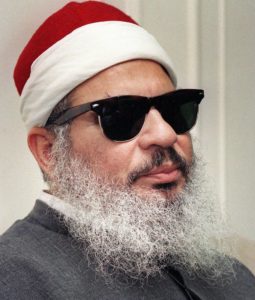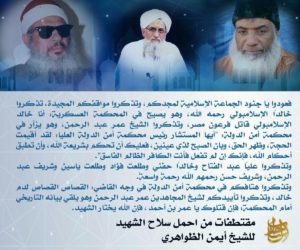News broke yesterday that Omar Abdel Rahman, an Egyptian jihadi ideologue, died in a US prison. Within hours of the reports, al Qaeda re-released a copy of Rahman’s last “will,” in which Rahman asked his “brothers” to exact “revenge” for his death.

The US District Court for the Southern District of New York convicted Rahman (seen on the right) on terror-related charges in 1995 and he was subsequently sentenced to life in prison. Rahman was convicted for his role in a conspiracy to launch terror attacks against several New York City landmarks, including the George Washington Bridge, the Lincoln and Holland Tunnels, the FBI’s main office in Manhattan, and the United Nations building. Investigators also found that he was involved with the jihadists responsible for the 1993 World Trade Center bombing.
The ninth issue of al Qaeda’s Al-Nafir newsletter, which was released online after news of Rahman’s death spread, carried a version of Rahman’s “Will to the Islamic Ummah.” In the text, Rahman complained of the treatment he was allegedly subjected to in an American prison, writing that the US is purposefully “eliminating the scholars who speak the truth.” (This is a common al Qaeda talking point, as the jihadis frequently accuse the Americans of targeting their “scholars.”)
Rahman claimed that the Americans will “eventually kill me,” either through poisoning, or by giving him spoiled medicine, or with an overdose of drugs. Rahman warned that the Americans will lie about the causes of his death, so the jihadis shouldn’t believe them.
Rahman, who was 78, died of natural causes, according to American officials.
His “will” has been a piece of jihadi propaganda since the 1990s.
“Oh brothers, if they [the Americans] kill me, and they inevitably will, then perform my funeral and send my corpse to my family,” Rahman wrote, according to a translation of Al-Nafir obtained by FDD’s Long War Journal. “Do not forget my blood and do not squander it, but exact a most powerful and violent revenge.” Rahman called on others to remember that he was their “brother,” “spoke the truth” and was “killed in the way of Allah.”
Al-Nafir’s version is similar to the text that was distributed in 1998. In The Osama bin Laden I Know, Peter Bergen wrote that copies of Rahman’s “will” were distributed at a press conference hosted by Osama bin Laden and Ayman al Zawahiri on May 26, 1998.
Rahman’s sons handed out a laminated card with their father’s will, as well as a fatwa authorizing attacks against the US, written on it. The text of Rahman’s last will described by Bergen appears to be the same as Al-Nafir’s, meaning Rahman first warned that the Americans were slowly killing him almost twenty years ago. He eventually died — and now al Qaeda is using his death to call for retribution.
According to the translation obtained by Bergen, Rahman’s fatwa read: “Cut all relations with [the Americans, Christians, and Jews], tear them to pieces, destroy their economies, burn their corporations, destroy their peace, sink their ships, shoot down their planes and kill them on air, sea, and land. And kill them wherever you may find them, ambush them, take them hostage, and destroy their observatories. Kill these infidels.”
Rahman’s fatwa has been credited with providing theological justifications for al Qaeda’s attacks, as not many sheikhs endorsed bin Laden’s early vision of global terror. At the May 1998 conference where Rahman’s fatwa and will were handed out by his sons, bin Laden announced that he had formed the “World Islamic Front for Jihad Against Jews and Crusaders.” It was this front, which Rahman’s sons supported, that brought the war to American targets in Aug. 1998, when the US Embassies in Kenya and Tanzania were bombed.
Al Qaeda frequently took up Rahman’s cause through the years. Bin Laden often cited Rahman’s case as an example of America’s supposed injustice towards Muslims.
In his 1996 declaration of war against America, Bin Laden portrayed Rahman’s imprisonment as part of an alleged campaign against Islamic scholars. In 1997, according to the Washington Post, bin Laden accused the US of fabricating “a baseless case against [Rahman] even though he is a blind old man.”
A Presidential Daily Brief delivered to President Bill Clinton on Dec. 4, 1998 warned that bin Laden and his men were working with Rahman’s group, Gama’at al-Islamiyya (IG), to orchestrate an “aircraft hijacking.” The intent behind the putative plot was to force the US to free Rahman and others. The plot didn’t progress, but it was later seen as an early harbinger of the 9/11 hijackings.
In Sept. 2000, Al Jazeera’s satellite channel aired footage of a meeting of several jihadi leaders in Afghanistan. All of them, including bin Laden and Zawahiri, pledged to free Rahman from jail. “We promise to work with all our power to free our brother [Rahman],” bin Laden said, with one of Rahman’s sons by his side.
Zawahiri also spoke, asking: “Which one of us today would not sacrifice himself for this man who has supported every righteous stand and has been an unshakable leader?” Zawahiri continued: “We have a duty towards Dr. Omar Abdel Rahman, who has never abandoned a righteous stand. Do we now abandon giving him support and rewarding him?”
Al Qaeda and other actors continued to seek Rahman’s release in the years since.
After the revolution in Egypt swept Hosni Mubarak from power in 2011, Rahman’s cause became even more popular. Mohamed Morsi, the Muslim Brotherhood figure who briefly served as Egypt’s president, promised his supporters that he would try to free the blind ideologue.
Members of Gama’at al-Islamiyya who were closely allied with al Qaeda also helped stage a protest outside the US Embassy in Cairo on Sept. 11, 2012. The protest was pro-al Qaeda, with the group’s black flag flying high and chants of “Obama! Obama! We are all Osama [bin Laden]!” ringing out. Some of the protesters cited Rahman in their rallying cries.
In Jan. 2013, Mokhtar Belmokhtar, a notorious Al Qaeda in the Islamic Maghreb (AQIM) commander, orchestrated a major raid on a natural gas field in Algeria. His men took dozens of foreign nationals hostage and demanded the release of Rahman in exchange for some of them. Authorities did not comply with the demand.
Al Qaeda still uses images and clips of Rahman in its propaganda.

On Feb. 18, the same day that Rahman’s death was announced, al Qaeda released Ayman al Zawahiri’s lengthy eulogy for one of Rahman’s longtime comrades, Rifai Ahmed Taha Musa, who was killed in an American airstrike in Apr. 2016. Taha and Rahman were both Gama’at al-Islamiyya leaders. Zawahiri praised Taha for taking part in the aforementioned Sept. 2000 conference in Kandahar, during which the jihadis called for Rahman’s release.
“Sheikh Rifai Taha, may God have mercy on him, took interest in the release of Sheikh Omar Abdel Rahman in deed, and not by merely begging America” to free him, Zawahiri said. Taha agreed with bin Laden that Rahman should be freed and said so during the conference, Zawahiri remarked.
Zawahiri’s video eulogy for Taha includes footage from the Sept. 2000 gathering, during which they praised Rahman. As Sahab, al Qaeda’s propaganda arm, used images of Rahman alongside Zawahiri and Taha to promote the video. (One such image can be seen above.) It may be the case that al Qaeda waited to release Zawahiri’s commemoration of Taha until Rahman died, as the timing of the video’s online distribution is especially conspicuous.
Al Qaeda in the Arabian Peninsula (AQAP) and Al Qaeda in the Islamic Maghreb (AQIM), both of which are openly loyal to Zawahiri, released a joint eulogy for Rahman earlier today. The statement was translated by the SITE Intelligence Group. The al Qaeda branches specifically mentioned Rahman’s will.
“We call upon the sons of Islam and its honorable knights, who were not successful in liberating the sheikh from his imprisonment, to earnestly and honestly work hard to execute his will, and to build from his blood a lighthouse that inspires the generations…to viciously avenge the sheikh against his oppressors and his wardens,” the statement from AQAP and AQIM reads, according to SITE’s translation. “This would be the least of what his brothers in Islam and pride should do,” the statement continues, as Muslims should “rescue…our scholars and our leaders who were faithful to Allah and never deviated from his path.”
Rahman’s teachings had a significant influence on the development of al Qaeda and modern jihadism. For more than 20 years, al Qaeda’s leaders made him a central part of their cause. The jihadis will almost certainly continue to use him in their productions in the years to come.








7 Comments
News reports on the death of Rahman this week noted that he preached at 1 or more radical mosques in NYC area in the early 1990s. Are those mosques in NJ and NYC still operating? Are the imans still preaching “Death to America”? What happened to those Muslims who sat through his rants?
As to Rahman’s burial, one doubts that he was flown, like Bin Laden’s corpse, to a US carrier for formal Muslim burial, with photographs of body and ceremony prohibited
If this guy was properly executed when he was convicted, we wouldn’t be reading this today. Allowing him to be used as a pawn has made everyday Americans less safe and just wasted our tax dollars. Our enemies will continue to use our weaknesses against us.
What a pile of human inhumanity, that Rahman was.
Explain your reasoning for reading all of this beyond just reporting. ….am I falling off the right side or are you giving credence to their ideology?
Are we now at the crossroads where everyday Americans must recognize that their decisions will be based on the reporting of events by elements whose views change with the wind, be it a fart or not. PLEASE, ..step back and become who you once were.
Yes, he should have been given the nine grams treatment years ago. What a waste of good cell space.
I believe the Americans poisoned him slowly over a 20 years span that’s why they didn’t send his corpse to the pig farm in upstate NY.
The Morsi Government in Egypt also demanded his release.